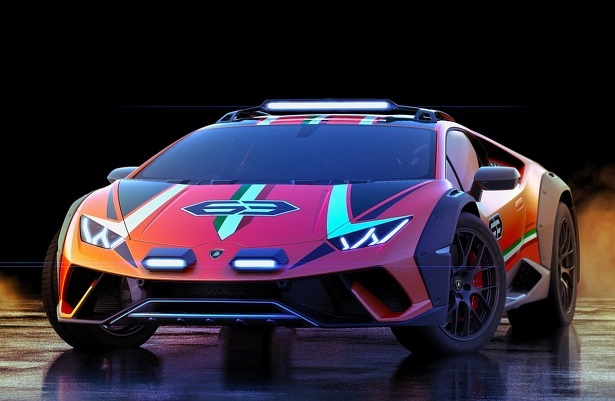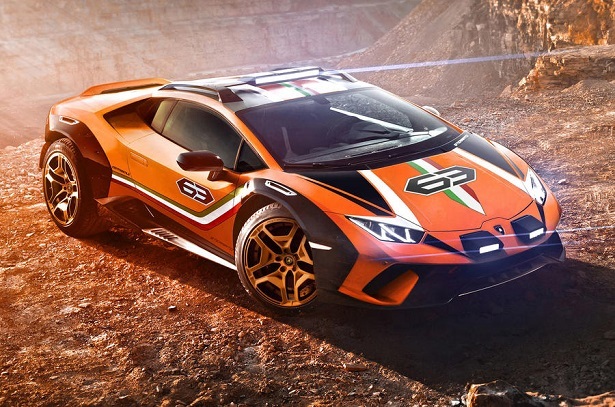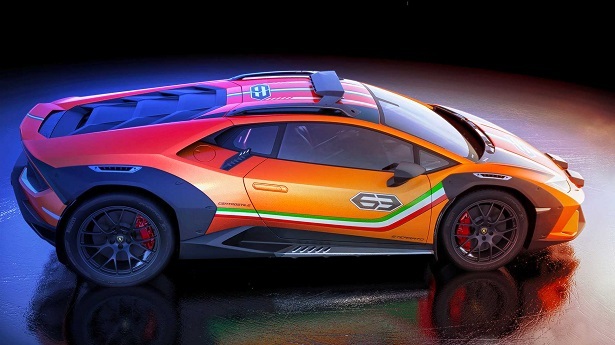The Lamborghini Urus performance/luxury SUV is clearly a sign of the times. We never thought we'd see one of the Italian exotic brands build another SUV after the legendary Lamborghini LM002 from the '80s, but here we are. We can't say we love the Urus's looks (the name means "wild ox" in Latin but comes across sounding like an unmentional body part). Now, Lambo delivers an off-roader that we can really get behind, and it's called the Huracán Sterrato Concept. It's based on the new Huracán EVO, but it's ready for less than perfect roads. Here are three reasons why it's better than the Urus.
1. It Looks Way Better

The Urus isn't a bad looking vehicle, but something gets lost in translation when the same design language for Lambo supercars are interpreted for an SUV. Sure, the quintessential Lambo angles are present in the Urus, but it comes off looking a bit awkward in our opinion. The Sterrato is quite the opposite since it retains so much of the Huracán's looks.
The body of the Sterrato gets the "ruggedized" treatment due to its dual purpose for street and dirt, but it really just looks like a tougher Huracán, and that's a good thing since the base car is one of the most beautiful Lambos to come out of Sant'Agata.

Take a look at the Sterrato from the front 3/4ths angle, and you can see how the Huracán design prevails. The large air intakes, angular headlights, and crisp body creases keep the look more unified than the overdone Urus. The unique rally-style paint scheme adds a dose of fun while keeping with the spirit of the brand. It's a modded supercar that doesn't lose any of the goodness of the original car and simply adds the right measure of badass to the equation.
2. It's Better Primed for Off-Road Antics

Though the Urus is eminently capable off-road, the Sterrato actually has more built into it to to make it a more off-road friendly than the Urus. Of course, there's increased ground clearance, an absolute necessity. But the Sterrato gets a widened track in front and rear with dedicated wide tires with stronger sidewalls and wider shoulders that were custom made for the car. The Urus can be outfitted with Pirelli Scorpio tires, and it has the biggest brakes of any vehicle in the world, but that's mostly because the Urus is 2.2 tons (4,850 lbs) of mass, whereas the Sterrato is probably just a tad heavier than the Huracan EVO (3,485 lbs).
The Sterrato also gets a revised LVDI system with both rear-wheel steering and a torque vectoring system is specifically tuned in for off-road driving. When the Sterrato comes in contact with low-traction surfaces, the system provides better grip. Increasing the four-wheel drive system’s rear bias increases torque and enhanced controllability in corners.

The car also gets underbody reinforcements and body protection like a rear skid plate/diffuser, a front aluminum skid plate, aluminum-reinforced side skirts, composite bodywork with stone-deflecting protection around the engine and air intakes, and carbon fiber and resin mudguards. The Urus can't brag about having two sets of LED lightbars, lightweight aluminum roll cage, four-point seatbelts, carbon sport seats, and aluminum floor panels like the Sterrato does.
3. It has a V10 instead of a V8

Some enthusiasts were disappointed that the Urus only had one engine option, a twin-turbo V8. While the Urus is plenty powerful, the sound was a bit disappointing. Rather than the angry growl of a V10 (Huracán) or V12 (Aventador), the Urus's engine note is a bit muffled and lacks the aural presence of a bigger-displacement engine with 2 to 4 more cylinders.
The Sterrato, however, retains the Huracán's V10 mill and churns out 641 horses, more than enough to send the car into some serious speed territory on and off-road. The power-to-weight ratio is also much better than the Urus's, giving the Sterrato better performance overall.

The bad part about all this comparison is that you can't actually buy a Huracán Sterrato. Only one was built for the purposes of seeing how the brand could exploit the excellent LVDI system and add off-road capability to a supercar without losing its ethos or drivability. There's no word on whether Lambo will build the Sterrato, but we're betting that after reading about the Sterrato, some rich guy (or gal) will pony up serious funds to have one commissioned for them.


